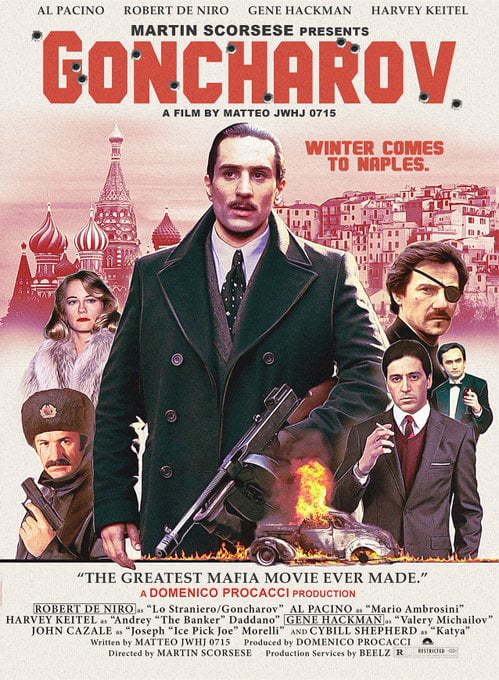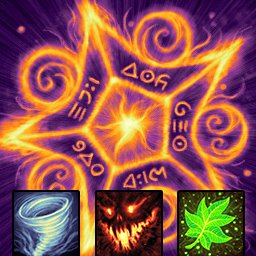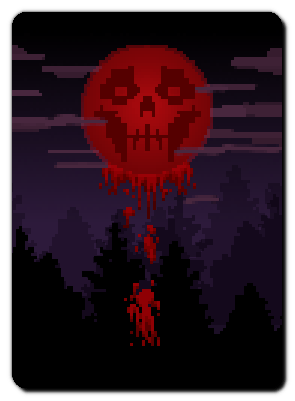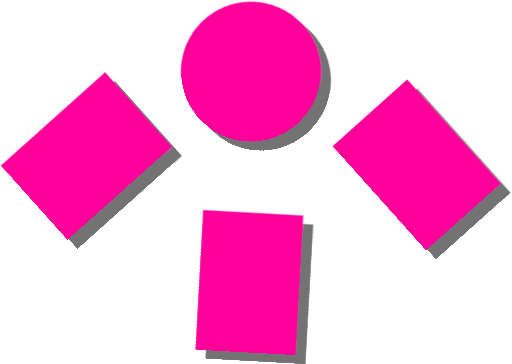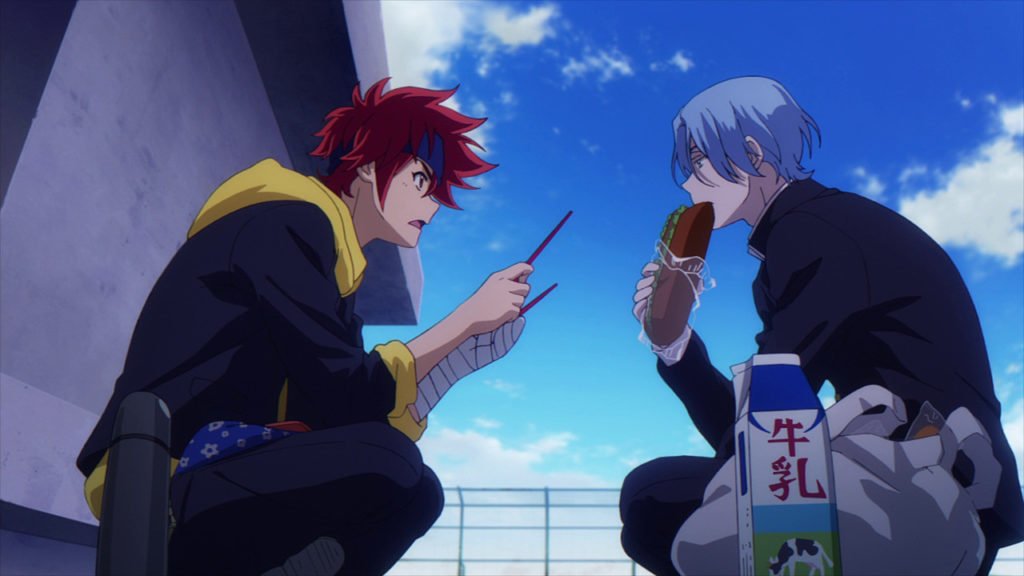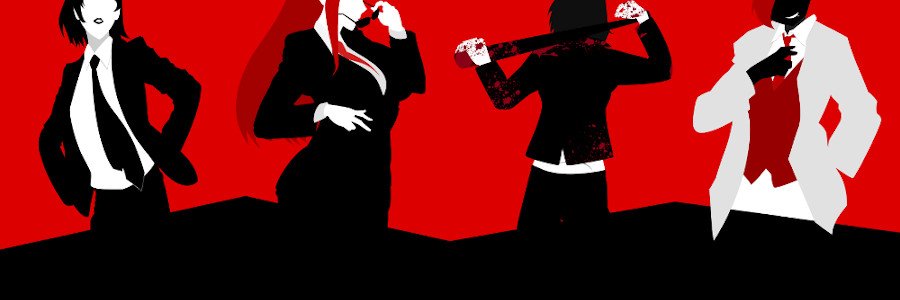Game Concept — Bad Advisors
Did you hear what the king’s advisors were talking about? Well, I heard from one of them, that they think that the other advisors are too focused on their wine, or their parties, or their lovers, or enriching themselves. Why, you didn’t hear it from me…

This is a concept writeup for a card game. The aim is a single-deck, form factor game which needs no sorting, you just shuffle it up and go. My aim is for a game that fits into our $20 range on Invincible Ink, so think like an ordinary deck of playing cards in terms of size.
As a setup note, this game imagines each player is pretty translatable to one another. You start the game by shuffling up a deck and dealing it out to everyone. The vibe here is something like Cockroach Poker.
Continue Reading →Game Concept — Lysen Co.
Welcome to your new position of Commisioned Human Resource Dispensation here at Lysen Co Food Technologies! We trust that you’re going to do your best for the betterment of all mankind as represented by the correct and accurate construction of optimal ‘tiger team’ panels for the full-time distribution of actualised test partners! Don’t worry, we know you’d never let us down – no member of our employment family ever has!
Continue Reading →Game Concept — The Path of Wandering Samurai
Thinking about another game idea. Gunna put it down here. You’re going to read it, maybe. I’ll be able to reference back to it. Either way, it’s a card game about wandering samurai.
Continue Reading →Game Concept — Moonshiners!
Alright, alright, I know I’ve been thick on the ground for game ideas lately. This one’s even more frustrating than normal because I feel like I could convince a university colleague to pump out AI art and beta test it with me in a weekend but I feel like that would be an abuse of our limited time right now.
Here’s the core of it: You’re all Appalachian, redneck ass criminal booze makers and sellers, classic moonshiners. To maintain your business you’re travelling into town every month with a load of product, and while you’re there, you offload product, you recruit gangsters, and you make money through a series of auctions.
Also, you’re werewolves.
Continue Reading →Game Concept — Packidge!
Here’s a game concept post! You’re going to get the pitch for the game, you’re going to get a rundown of the rules, then a description of what the game needs.
Continue Reading →Game Concept — Shaky Hands
This is going to be one of those ‘write up a game idea’ posts I do – if that’s not your jam, that’s okay! It’s just going to be me taking notes on an idea, and trying to explain it to a general audience. In this case, I’m not approaching a game aesthetic or art resources, but instead I’m approaching a purely mechanical idea to see what fictions can connect to it and what material components I’d need.
Continue Reading →Game Concept — Goncharov Card Game Concepting
I am tired and my brain hurts and I am exhausted as I try try try to make graphic work for Bloodwork happen. The website is down and up and down again and that’s maddening as hell, and the dog is weird and the dishwasher’s replaced and aaaaaa so what I decided to was exorcise a brain worm about a Goncharov card game.
Continue Reading →Game Concept — Boyfriend Material
I default to tabletop games when I make games. It’s the skillset I have and it doesn’t involve, typically, reaching into a new skill space to try and develop something. But it’s not the only system I’ve ever used, and there is a design that I’ve had kicking around in my head for an idea of a few different visual novels, or maybe even RPGmaker style games. One of them that I think has a perfect name to go with its concept is Boyfriend Material.
Continue Reading →January’s Game Project: Adventure Town!
Adventure Town is a roll-and-write game about running a town that adventurers pass through, a type of thing that I seem to find really fascinating.
Gunna level with you: I had a lot of writing to do this month. I work on it a little bit at a time, trying to find time to make pushes to finish it, especially since it seems to me to be a really easy project to just get finished, but tell you what: I haven’t had the time in January. This is life, and part of my life in January was a combination of helping someone move, a convention, and a lot of writing for the most important project of my life.
Adventure Town suffered. But it didn’t get nothing done. Particularly, what got done was a very important thing, in my mind: I stopped trying to make perfect mechanics, and managed to instead, get some good mechanics down.
Continue Reading →Prototype 22.12 — The Wrapup
Well, time to take a loss.
Continue Reading →Prototype 22.12 — The 2022 Prototypeapalooza
Just wait someone’s going to tell me ‘palooza’ is racist or something.
This year each month I dedicated some time – varying in scope and effort – to prototyping a new game. Of these games, two of them got to what I consider ‘made prototype’ stage, where I have a physical game that I can hold in my hand and share with people for proper playtesting. And that’s cool!
But I decided what I wanted to do this month, this December, was to look at the games I got, in what stages they are at, and determine what can I do with them in this last month to place orders for the rest in the hopes they’ll be available and my decks will be clear for next year to continue this process.
Presented then is a list of the games, based on the order I want to talk about them.
Continue Reading →Prototype 22.11 – DIY Touhou
Doing something different this time.
I am first up going to tell you what I wound up making and show you some examples of it. I’m going to explain where it’s at, and that’s all going to come before the fold. The full diary, which is a repost of material written over on my Cohost, is going to follow after. And we’re going to talk about sites like Cohost at some point in the next month or so, wew lord.
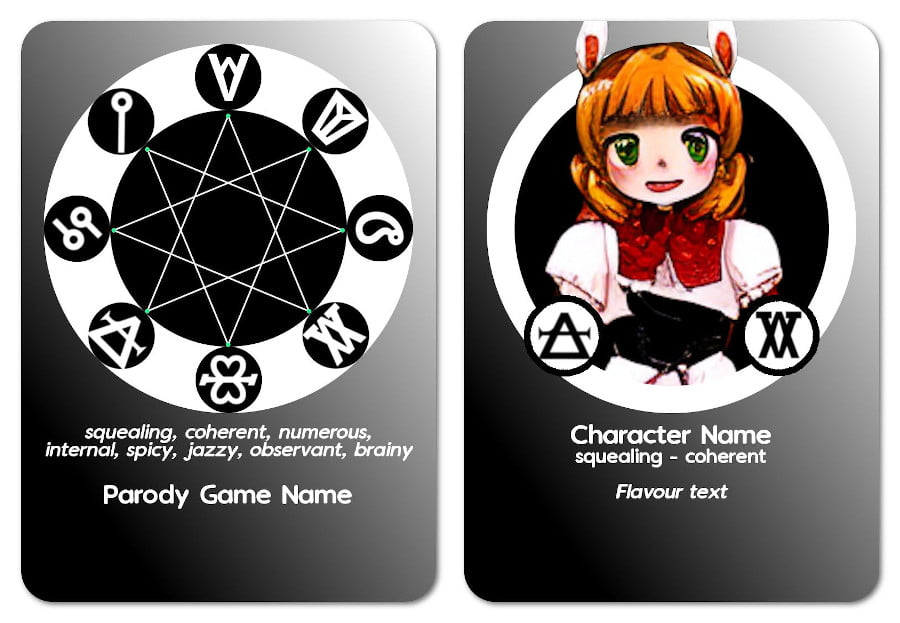
What I made this month is a prototype game design for a simple card game with a homogenous play form, focusing on hand management built on a classic mathematical puzzle you might see in the games Spot It and Dobble. The game has room to expand mechanically if it needs it, with each card having room for a rule or game mechanic to add to each character.
The game is composed of a deck of functionally similar cards; each card has a unique front and back. Each front face shows an alchemical summoning circle that describes a reading of a calamitous time, and a description of that in a set of keywords. The back face shows a magical girl from a mystical other realm (with art from the Touhou AI art bot) who represen two of those alchemical symbols and two of those key words.
The first turn of the game, you deal a number of these cards so their summoning circle faces are visible to the table, then deal each player a hand of magical girls, back-face-up. The deck is passed around from player to player, who get to do things to manage their hands, while they try and build a hand of cards that lets them ‘claim’ one of the quests as done.
That’s the game play experience, and cycle. I like that this needs no special components, and if it’s put in to a tuck box, it won’t need tons of setup. I also like that this prototype has room to develop: Each card could have a unique mechanical rule, a flavour or name joke, and the list of adjectives and alchemical symbols gives a lot of room for non-meaningful differentation.
Good idea, I like it, I did not get the time to order a prototype, but thanks to practice on Straight Outta Tucson, I have a tool available to me that can make turning this from ‘list of filenames’ to the actual cards very conveniently.
Dev diary follows!
Continue Reading →Prototype 22.10 — Camp Osum!
You know how I write these things ahead of time?
I’m writing this like twelve hours ago. Or twenty four? I’m not sure, I am tired.
Continue Reading →Prototype 22.09 — Lane Chase
Every month of 2022, I am trying, as part of both my PhD project and my all-purpose general game development, develop if not a whole game for game development, a project start, such that I can make playtest prototypes. This is a sort of report of the process throughout the month.
What I started with this month was this:
This little Y unit that creates, in a player space, and in the process created lanes.
I didn’t get much time to work on this prototype this month. Honestly, I didn’t really get any time — this project hit a wall early on because this month had other demands. I’m embarrassed by it but I’m also just admitting it. This month has to marking crushes and a pressure point on the non-fun bits of the PhD (you know, all the paperwork that is meant to build off this design).
But still, this idea yielded some thoughts.
Continue Reading →Update: RA-Nime
Hey, remember this game idea?
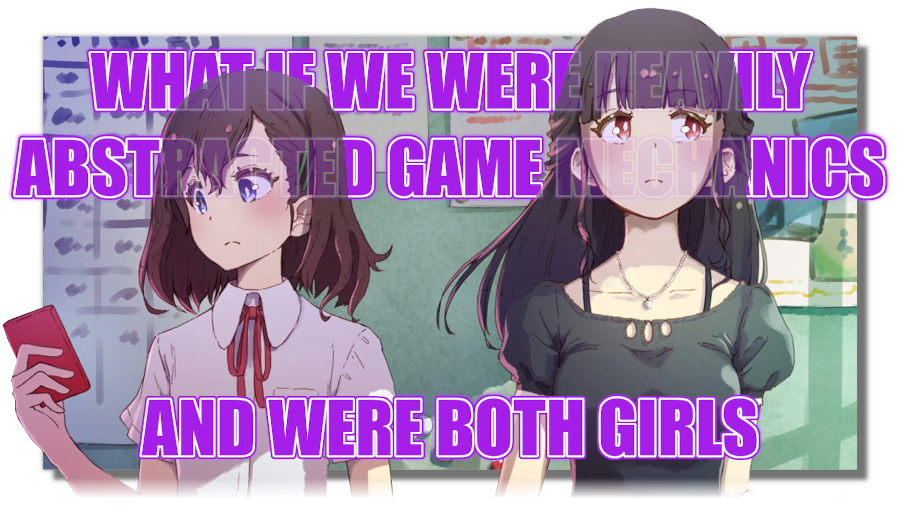
What have we learned about this game in a few months?
Continue Reading →Prototype 22.08 — Switch Stances
Every month of 2022, I am trying, as part of both my PhD project and my all-purpose general game development, develop if not a whole game for game development, a project start, such that I can make playtest prototypes. This is a sort of report of the process throughout the month.
This month I got to the outline stage of designing a trick-taking game which is now firmly at the ‘make a prototype and see how it plays in person.’ And it’s about skateboarders, and I have a challenge now about aesthetic choices.
Continue Reading →Prototype 22.07 — Corner Hustle
Every month of 2022, I am trying, as part of both my PhD project and my all-purpose general game development, develop if not a whole game for game development, a project start, such that I can make playtest prototypes. This is a sort of report of the process throughout the month.
This month has been busy. Not in a fun way. Nonetheless, any work on an idea is work on the idea, so let’s talk about that.
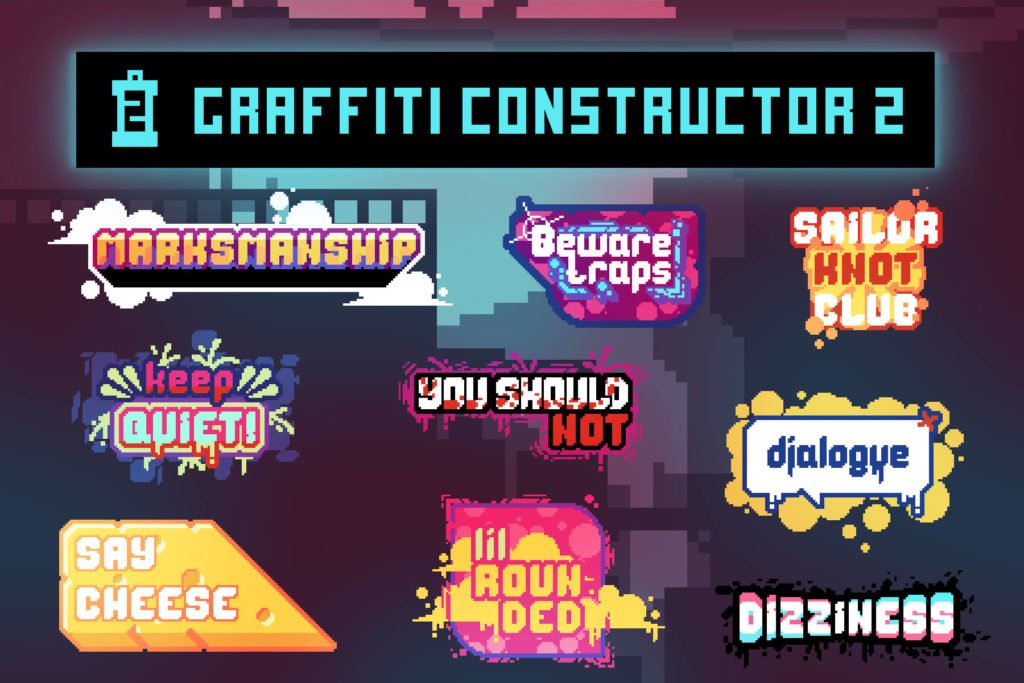
Prototype 22.06 — They Were Roommates
Every month of 2022, I am trying, as part of both my PhD project and my all-purpose general game development, develop if not a whole game for game development, a project start, such that I can make playtest prototypes. This is a sort of report of the process throughout the month.
They Were Roommates (temporary name, change this) is a game about getting all your bags in order and finding a solution – any solution – to getting a room where you can all spend the night for a con, even despite any inconveniences.
You ever go to a convention? A travel-from-your-home, get-a-hotel-room, spend-the-weekend, indulge-and-experience-and-relate kind of convention? In my experience, every con has sort of more or less the same kind of stuff, even if there’s an emphasis. You’ll find videogames at an anime con and anime at a gaming con, if you know where to look (usually near my table where I’m selling it). The general mish-mosh of interests mean that even at non-furry cons, there are some furries.
I started this month looking at some avatars for a game design that I kind of liked. After consideration though I jumped through some hoops and put that design onto a backburner (in part because I have some ideas for a different game using those pieces).
Image
Continue Reading →Prototype 22.05 — Monster Line
Every month of 2022, I am trying, as part of both my PhD project and my all-purpose general game development, develop if not a whole game for game development, a project start, such that I can make playtest prototypes. This is a sort of report of the process throughout the month.
It says a lot about the design this month that I’m looking at my mocked up preview cards from late in the month and quietly being annoyed that it’s going to take me a while to get a test print of this game delivered to my house to play around with it.
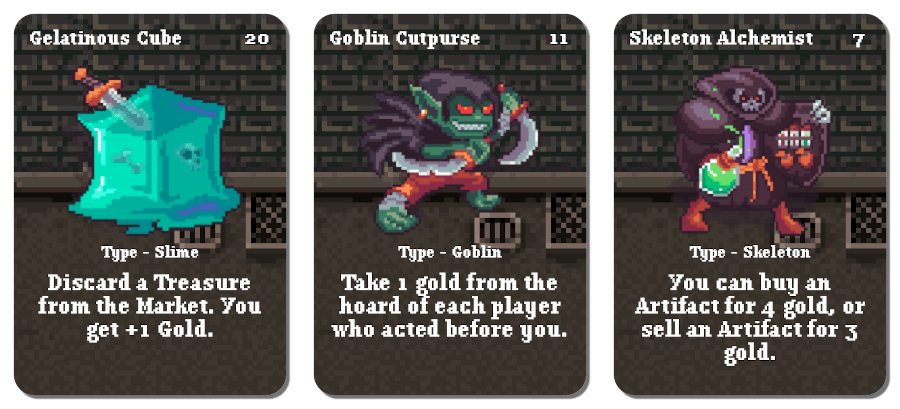
Prototype 22.04 — House Advantage
Every month of 2022, I am trying, as part of both my PhD project and my all-purpose general game development, develop if not a whole game for game development, a project start, such that I can make playtest prototypes. This is a sort of report of the process throughout the month.
In 2016, I made a game playable with a deck of playing cards, a single session tabletop roleplaying game that was designed to get everyone in the experience of being a DM. I made it and did the graphics myself – these four pictures of the four types of character, Hitters, Fitters, Grifters and Lifters.
I’ve wanted to make a game based on this for a while now, something small, something that plays with pieces I didn’t get to play with for a while. I wanted to make a game you could slip into a little bag, which came with some tokens and some cards, and let you play out the fantasy of The Suits in a different way. Rather than telling a story, though, the idea this time around was something tactical, something about robbing a casino.
And something about poker.
Continue Reading →Prototype 22.03 — Sky Islands
Every month of 2022, I am trying, as part of both my PhD project and my all-purpose general game development, develop if not a whole game for game development, a project start, such that I can make playtest prototypes. This is a sort of report of the process throughout the month.
In January, I started late and didn’t get it done. In February, I had four game ideas. One of them became focal, and I spent some time this month actually making a physical prototype. My plan this month is to have something that at the end of the month can be treated as a thorough plan for not just a prototype, but a game that’s ready to go.
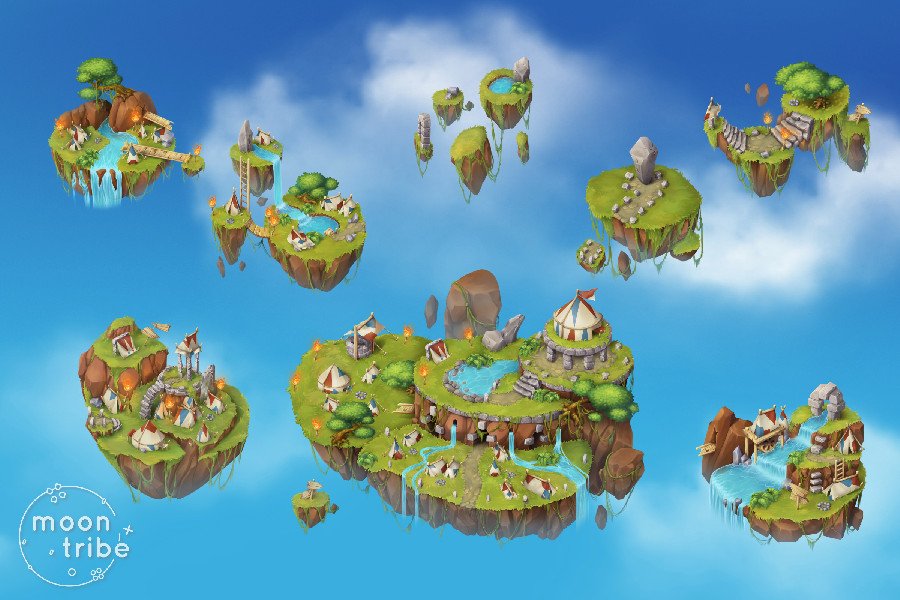
That proved very stressful, with the whole design write-up being week to week, and publishing just before the end of the month. Instead, I’m going to talk to you about what the idea is and focus on the core ideas, rather than on every step of the process.
Let me know if you prefer the week-to-week explanation or this style of simplified version.
Continue Reading →Prototype 22.02 — RA-Nime
Every month of 2022, I am trying, as part of both my PhD project and my all-purpose general game development, develop if not a whole game for game development, a project start, such that I can make playtest prototypes. This is a sort of report of the process throughout the month.
What game did I try to make this month?
Continue Reading →Prototype 22.01 — Adventure Town
Halfway through this month, I sat down with my supervisor and we discussed the idea of what this year is going to look like for the PhD. One of the things that we discussed was that large projects were slow and hard to move, and the material I had access to was harder to access thanks to the global shipping crisis. Services like Gamecrafter and DriveThruCards were unreliable, sometimes simply refusing to ship to Australia at all. Anyway, point is that I’m trying to make a print-and-play game each month this year.
But I decided this with ten days left in the month.
Hrm.
I was not going to get this done. Not properly done, not done in a way I’d be happy with. But I do have a game where the core idea of it is something I’ve been turning over and over in my head for years now in the idea of making a print-and-play game for the year.
Therefore, here, I am just going to provide an honest accounting of what I did, this month, to work on Adventure Town and how close it is to being complete.
Every month of 2022, I am trying, as part of both my PhD project and my all-purpose general game development, develop if not a whole game for game development, a project start, such that I can make playtest prototypes. This is a sort of report of the process throughout the month.
Continue Reading →
Working on Black Jack’s Dungeon
If you follow my twitter, and like looking at me making things, you may remember seeing me work on a card game that looked a bit like this:
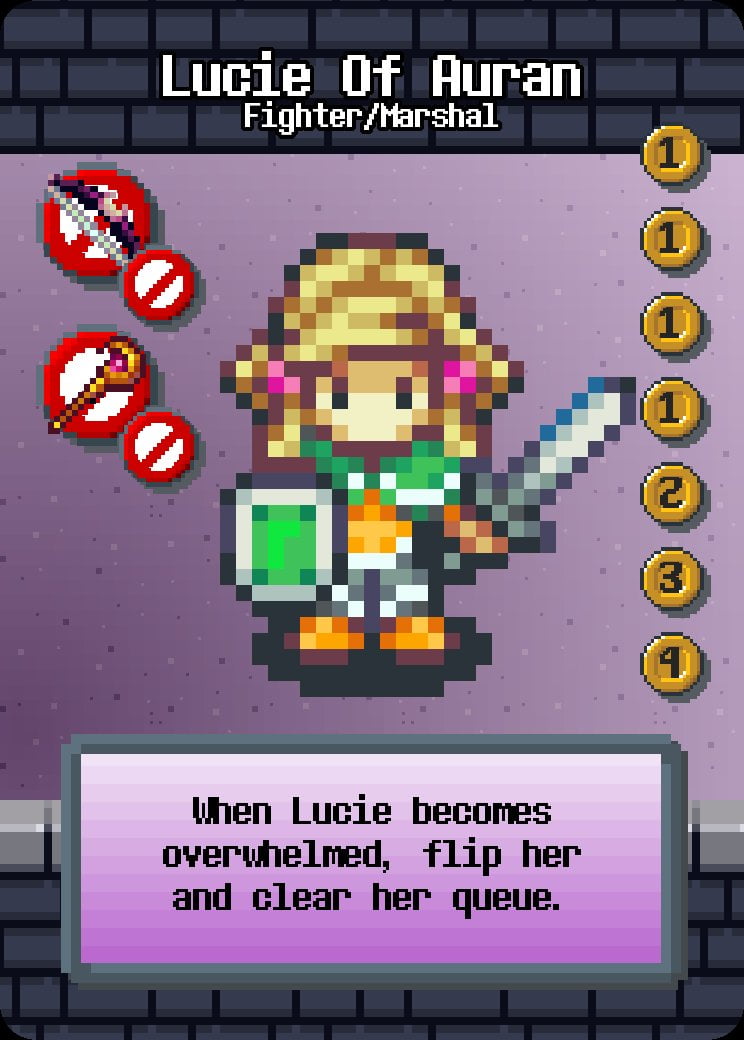
This game was called Black Jack’s Dungeon, and it was created and tested and then I made a proper prototype to test it out more extensively. When it comes to really large games, it can be hard to do playtesting and prototyping with just myself and my small group, because it’s harder to make the proxies work well. An engine that works okay when it’s shrunk down may feel really dull when it’s scaled up.
I made the prototype and found that there were some problems that the game was having when it was scaled up to full size.
- It was really slow! The original design relied on players flipping cards until they were satisfied and chose to stop, or overdid it, and ‘went bust.’ This is a bit like how Sector 86 works, but there wasn’t a solid way to handle needing to ‘dismiss’ enemies. Originally, players could choose to take monsters other players flipped, which gave it a cooperative element. This design is still something I can do, but it needs simpler enemies.
- It was really uninspiring! The heroes all had simple mechanical abilities, meaning that building a party was just a matter of what art you liked. Since there was one character who had a very special ability (turning into a cow when she was hurt), that made her stand out in a weird way alongside the others.
- The actual resolution mechanic for the whole game was just a matter of finding one card of many, and that was kinda boring!
- With lots of heroes, but you only getting three a game, it was kinda a bummer to never get to play with most of them, especially when a lot were really dull by comparison. The art was nice, I should make these things desireable.
- I used pixel art very sloppily. In a pixel art game, all art should use pixels of the same size (I am led to understand), and I didn’t. This made some of the art extremely unsettling to people who are inclined to notice this kind of thing.
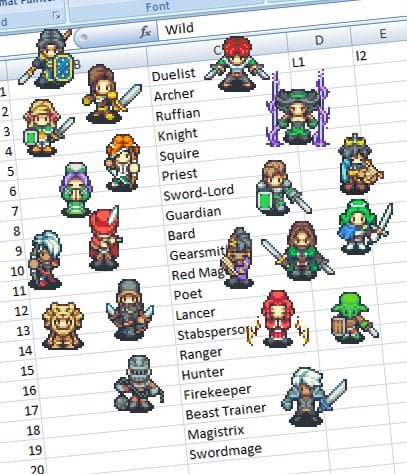
I went back to the drawing board. Obviously, it’s not been a high priority, but it has been on my mind more as of late, what with you know, the thoughts about games that are playable without a large group of people. Particularly, this game struck me as an interesting option to make as a strictly solo, big-deck game.
(Huhuh, big deck).
My current idea is to design a game where cards are adventuring parties – that you will have one card, with one to five heroes on it, and they have goals and types of prizes they will keep for themselves, when you send them into dungeons. Dungeons will be decks, set up around your little town. To send adventurers into a dungeon, you shuffle their card in, then, in another phase, you flip cards from the top of that dungeon until that hero card pops out – then you sort through the revealed cards and see what that means. Sometimes those cards are just smashed by the heroes; sometimes, they rout the heroes and you have to help the heroes recover.
This is the new mechanism in my mind, where you’re the town sending out and supporting the adventurers. It also gives more room for complex party mechanics, without needing to make 20 cards for all the adventurers.
Reaper Space
don’t go there
it’s reaper space.
Everyone warns you when you move through the ports and bases and outposts. It’s the big zone where ships don’t travel; trade routes route around it; no corporate rig will travel into Reaper space at all. Not any of the big ones, at least, not one of the superheavies. Reaper space is uninsured space. Nobody’s dragging you back out of that.
You haven’t seen a Reaper, of course. Nobdoy has, or if they have, they don’t know it. Nobody’s that sure about the way the Reapers look, though there are a few of their artifacts. You’ve seen one – hanging once in the foyer of a citadel, dangled from the roof, this immense machine that looked like a tank, with an entire assortment of blades on the front and an enormous engine out the back, seemingly made to do nothing but plow forwards; the blades were attached to a wheel, which was itself screwthreaded – so each blade flicked and clacked and dug into the air when they ran the machine –
Which they did, for a little bit.
For demonstration purposes.
Watching it turn an entire shuttlecraft into pieces with all that sound, the shredding and breaking.
Brr.
It’s not like you need to worry about Reaper space. Reaper space has barely any planets in it, and there’s only one outpost out near the dead zone that serves as a border to Reaper space. Maybe a few planets, sure, probably with some cultures on them that are probably not spacefaring, or if they spacefare it’s to do minor, small trades – the trades of a culture that doesn’t have an empire or corp yet – and when the talk of reapers happens they just shut down their satellites and pretend nobody’s home.
There are pirates, of course.
After all, uninsured space is unpatrolled space.
Gotta be careful out there. It’s Reaper space, but it’s full of scum and villains too.
Hunter’s Dreams – Handling ‘Race,’ Part 2
This is more work on Hunter’s Dream, a 4th Edition D&D-compatible mod made to enable a Bloodborne style of game, where players take on the role of hunters, who have to first research their prey before going out to the tactical combat stage of things where players get to have cool fights with werewolves and whatnot.
Last time I outlined some of the problems with ‘race’ as she is treated in the game of Dungeons and Dragons 4th Edition, the challenges of making settings through the ‘race’ option, and the potential, unconnected legal concerns with how to treat races so as to not invalidate the rules of making 4th edition D&D content.
Those are our parameters, the problems we need to consider. Now let’s talk about what I’m going to choose to overcome this.
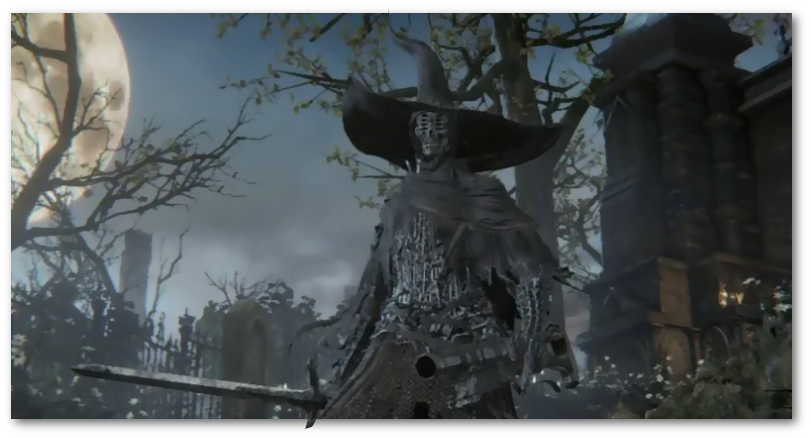
Hunter’s Dreams – Handling ‘Race,’ Part 1
This is more work on Hunter’s Dream, a 4th Edition D&D-compatible mod made to enable a Bloodborne style of game, where players take on the role of hunters, who have to first research their prey before going out to the tactical combat stage of things where players get to have cool fights with werewolves and whatnot.
This time, he said, in the tone of voice of a breathless white boy who has just completed his first college course on the topic, I want to talk to you about race.
Race in D&D is a fraught topic, so going ahead, we’re going to talk about some things that are racist, and we’re going to talk about trope space and fantasy novels, and how those things are going to be racist too. Just be braced. This is before we talk about the choices I’m making in Hunter’s Dream as much as it is about me thinking my way through the problem and whether or not it’s good to address it in this.
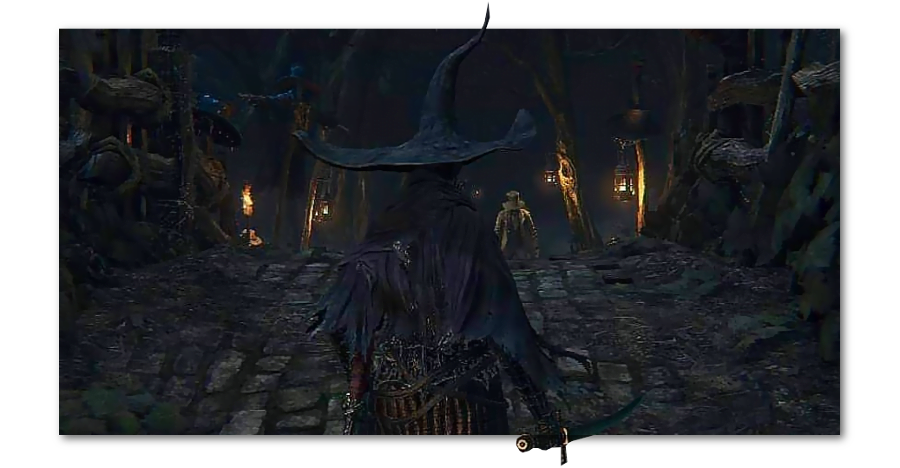
Hunter’s Dreams – Trick Weapons, Part 3
This is more work on Hunter’s Dream, a 4th Edition D&D-compatible mod made to enable a Bloodborne style of game, where players take on the role of hunters, who have to first research their prey before going out to the tactical combat stage of things where players get to have cool fights with werewolves and whatnot.
Last time, I discussed how 4th Edition D&D’s weapon system works, and today, I’m going to lay out some basic ideas of actual mechanics for use in Hunter’s Dream.

Hunter’s Dreams – Trick Weapons, Part 2
This is more work on Hunter’s Dream, a 4th Edition D&D-compatible mod made to enable a Bloodborne style of game, where players take on the role of hunters, who have to first research their prey before going out to the tactical combat stage of things where players get to have cool fights with werewolves and whatnot.
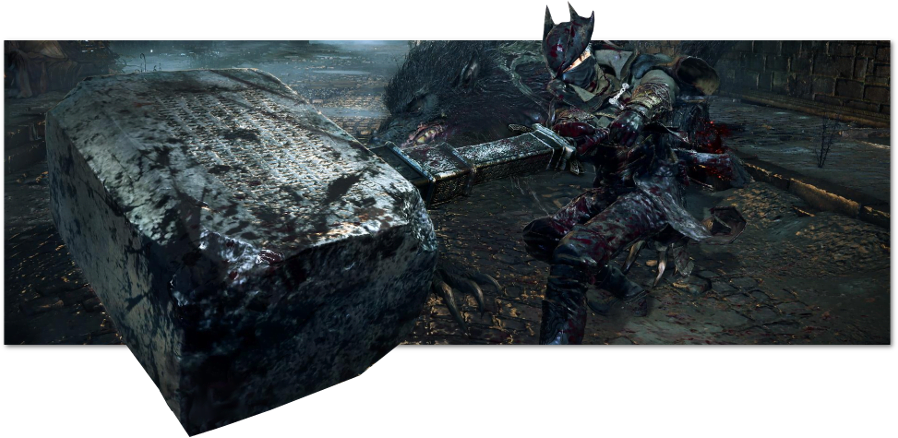
Last time, I discussed the basics of what a Trick Weapon does in Bloodborne, and today, I’m going to talk a bit about how 4th Edition D&D can handle some of those ideas.One of the reasons wanted to do this in 4th edition D&D is because the weapon system in 4e is really good compared to every other edition of D&D. Without delving into why and how other systems were bad (but they definitely were), let’s look at the things the weapon system in 4ed D&D has.
A 4th edition weapon has the following basic stats:
- a proficiency type (simple, military, exotic)
- a handedness (one-handed or two-handed)
- a range (melee or distance)
- a damage range (one or more dice representing the damage the weapon does)
- a proficiency bonus (determining any bonus to hit the weapon has)
- a weight (for encumbrance rules, which I’m no fan of, but this is our life)
- a group (to represent what other types of weapons it’s like)
- properties (one of a set of keywords that give the weapon specific abilities)
The weapon properties are as follows:
- Brutal
- Defensive
- Heavy Thrown
- High Crit
- Light Thrown
- Load Free
- Load Minor
- Off-Hand
- Reach
- Small
- Stout
- Versatile
Some of these keywords are very specifically utilitarian – a thrown dart would have Light Thrown, while a throwing axe has Heavy Thrown. A light thrown weapon uses your dexterity, a heavy thrown weapon uses your strength. Some of these, like Load Free and Load Minor relate to the unifying mechanics of the set they’re in (Crossbows and how you load new crossbow bolts).
The main thing about these keywords is that when you’re using the weapon, these keywords are very light on your cognitive load. Consider Defensive. A defensive weapon is as follows:
A defensive weapon grants you a +1 bonus to AC while you wield the defensive weapon in one hand and wield another melee weapon in your other hand…
Now, this has a few things that relate to it – it could be seen as kind of ‘choice intense’. You get an AC bonus with the specific condition presented here, but you need to pair a weapon with the defensive type, and you need another weapon, which must always be wielded in one hand. So hypothetically, any time you put this weapon down, your AC changes, and any time the weapon in your other hand changes, that also has a chance to change your AC. In a videogame with things like disarms or throwing weapons, this could be pretty complex.
In 4e though, a character is not likely to be disarmed; they are likely to configure how their character works, the way they approach combat, and once that decision has been made, this defensive weapon bonus just folds into the way the character works.
Brutal is my favourite. Brutal N means that when you roll a value of N or less on the damage dice, you can reroll it. This is a great mechanic because it can be a small nudge, statistically (a 1d12 weapon with brutal 1, for example, is an increase on average of .5 damage per attack) but it can feel really fantastic to cash in a 1 for even a 4. What’s more, some brutal weapons prevent feel-bad low rolls on ‘big’ weapons like the Executioner’s axe (Brutal 2), or intriguing, exciting experiences with weapons like the Mordenkrad (which rolls 2d6 – but both dice are Brutal 1).
There’s also the weapon group and proficiency type. Proficiency types push characters towards a certain general type of weapon based on their class’ background; rogues and fighters are likely to be familiar with most swords, for example, but clerics and druids aren’t. That means that you can gate access to things mechanically, which you can use to set the tone for some characters. Shamans and druids use clubs and staffs and spears, which aren’t that good as pure weapons, but it’s okay, because they’re not as likely to need them. If a player wants to reach out of their proficiency group, that’s fine too.
Finally, there’s the weapon groups – that is, the kinds of weapons these things are, what they’re like, and what they do. In older D&D editions, there was a trend towards trying to put a weapon in a big group (simple, martial, exotic) and that’s it; special training may refer to a specific weapon, but then you got weird things like how the Bladesinger would refer to a character using a longsword or rapier or elven rapier. Instead, in this case, weapons fit into general groups, and weapon styles or feats can refer to doing attacks with types of weapons. Most interestingly, weapons can have multiple groups – so if you build a character who can do things with polearms and things with axes, a weapon that is a polearm axe represents an intriguing opportunity to do both.
These are good properties because the mean that the experience of using these weapons is qualitatively different than in other systems. You set the weapon up, and then you use it – Notably, there are a lot of things these weapon properties don’t ask you to do.
- They don’t include a lot of memory issues
- They don’t ask you to commit within the action economy
- They can handle choices made during the attack, like versatile
- They don’t want to be too specific
There aren’t any weapons that have a unique property; none of these weapons have a unique mechanic. That means a weapon property wants to exist on at least two weapons. That’s good – that suggests any weapon property invented needs to be made with a mind to being reused. Anything too specific probably doesn’t want to belong here.
Next time, we’ll talk about how these two idea spaces interact.
Hunter’s Dreams – Trick Weapons, Part 1
I started work on Hunter’s Dream back in January, with the basic idea being a way to play a Bloodborne style game set using 4th Edition D&D. The reasons are pretty easy to grapple with – starting with ‘I like it’ and moving on to ‘Bloodborne’s play experience is a tactical game of resource expenditure, not a story game of improvisation.’
Still, 4th edition D&D is a game of systems, and that means when you want to put something in the systems, you want to put in some rules. In Bloodborne, the trick weapons are a big part of the tactical experience, and they make the game feel that particular steampunky way. How then, do we bring that feeling into 4th ed D&D.
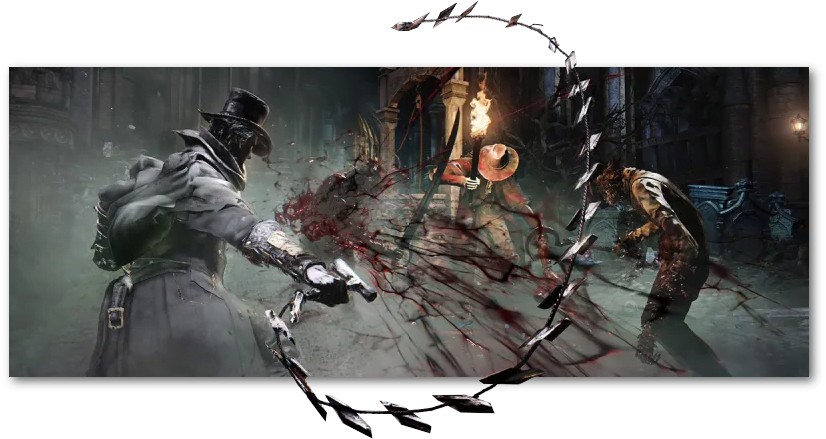
When looking at implementing these trick weapons in 4E, we want to consider what they do and how they do it. That sounds like basic stuff, but those questions are going to illustrate the difference between the two types of games and how I can make something that feels right in a different game.
Trick weapons in Bloodborne are weapons; you use them to attack opponents, destroy objects, and occasionally interact with environments in surprising ways – think about the times you cut a rope or knock down a hanging treasure. Broadly speaking though, the trick weapons are weapons, which you use to hurt people.
When you use them, you can change them from one form to another. Now here is where we can get a bit McLuahnish, and point out that medium and messages intertwine. See, Bloodborne is a videogame, and you play it with a controller. That controller has a number of buttons, and you, as a player, are expected to track maybe about seven to eight of those buttons at a time in combat. That means any mechanic you introduce, if it’s going to happen in combat, needs a button, and it needs a reliable button, because this combat is pretty high stakes. The game design is also what I call ‘fixed animation’ length – that is, when you commit to an action, you’re often stuck with it, and unlikely to be able to assert control over it along the way.
Following that, then, is that the trick weapons need to be weapons where your ‘trick’ doesn’t take a lot of buttons or fine customising. If you do those things, it’d take more time, and that might make it too inconvenient. With only limited inputs, then, the Bloodborne trick weapons are very binary. They’re either ‘on’ or ‘off’ – and you can swap them between one thing or the other in-combat. There are a few oddballs, of course, but generally, these weapons exist in form A or B, and in combat, shifting from A to B or vice versa results in a special attack.
Most of these weapons change in ways that reflect the technology of the setting. For some, the change is a big physical object shift; for others it’s turning on a special ability for the next hit. The weapons can’t be ‘normal’ weapons, even if they mostly resemble them – swords that become hammers, axes that become polearms, that kind of thing.
These two states want to be qualitatively different, in the context of Bloodborne; you’ll sometimes get different damage types, different speeds of attack, and different reach. In this game, those are very small spaces. Attack speed can be fractions of a second; Reach can be important down to similarly small units of distance.
To summarise:
- Bloodborne trick weapons are weapons
- They’re primarily used to hurt people and interact with the environment
- The trick of Bloodborne trick weapons is simple to use
- This differentiates them from conventional weapons
- There’s still room for mastery
- These weapons vary in how they attack
- Reach
- Speed
- Damage
- Special effects
This is our outline, the parameters we want to consider. Next time we’ll look at the challenges of setting this up in 4ed D&D.
Project: You All Meet In An Inn
The Pitch: You’re playing a quest-giver at a local tavern, trying to make sure you hand your quests to the idiots most likely to succeed at it. You’re not the only one, though, and all the other players are vying to lure these adventurers on their particular quests, like a sort of ambulatory workboard. You need to pull together adventurers, earn coin to incentivise more parties, and hopefully get your own ends met by the end of the game.
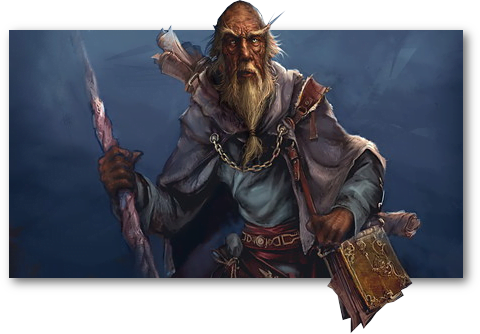
Details
You get a bunch of cards known as Quest Cards. Those Quest cards have some flavour on them, and then a set of symbols indicating what they need to be completed, and maybe have marks on them indicating things they ban (like maybe the quest to seduce the necromancer bans all ‘holy’ characters).
Those quest symbols are also on the Adventurers cards. These cards indicate the kind of thing they can do, and have a card back indicating if that adventurer is amenable to questing alone, in a pair, or as a full party. They’re arranged in a grid of three rows, like so.
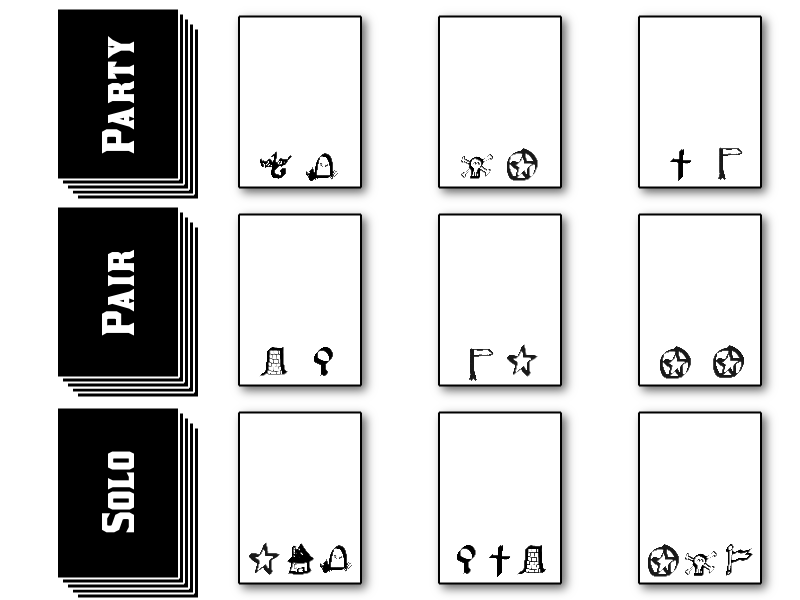
When you use a quest card, the adventurer (or adventurers) head out, and sit on that quest until … some timer. Not sure. Whatever. It’s a turn-based game. When they finish the quest, they return to the bottom of the deck they came from, and you get some fraction of the rewards and quest objectives. You can spend the reward money (hey, you think quest-givers are giving you everything your work earns them) to add to other quests, which means other adventurers are more likely to get them.
This whole game is modelled on Splendour; the grid arrangement, and the sort of economy of opportunities. There may be something like Splendour’s investments, too – maybe some of your quests make all your quests later easier because you have a reputation to uphold.
Needs
This game is going to need art. Since I now have a fund of sorts from Patreon I’ve been considering comissioning a bunch of adventurer art, of characters hanging around in an inn, but there’s an added challenge here: I don’t think I have it in me to design some 100+ characters, let alone give them enough to be meaningfully personable without using things like templates.
This has me considering maybe running a kickstarter with a cheap tier that’s just ‘we make your OC into a card and you get a nice high-quality copy of the art.’ I dunno.
At this point the volume of cards has me wondering if it needs to be a tight small-box 120 card game (as I make on Drivethrucards) or if this wants to graduate to be the next big thing as a small-box game that comes with tokens and markers.
If you think this sounds cool, if you think you’d want to chip in for art of your character, or if you’d back it on kickstarter, encourage me, dangit. I don’t know what I should be doing.




